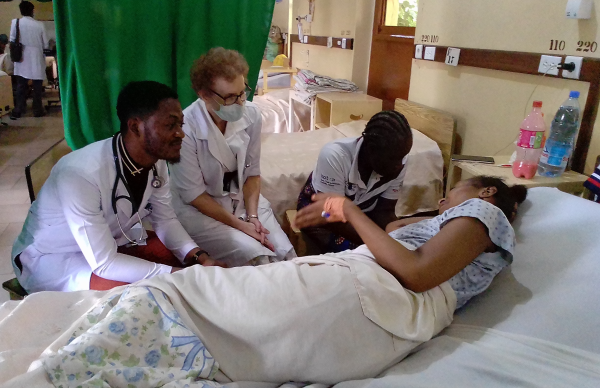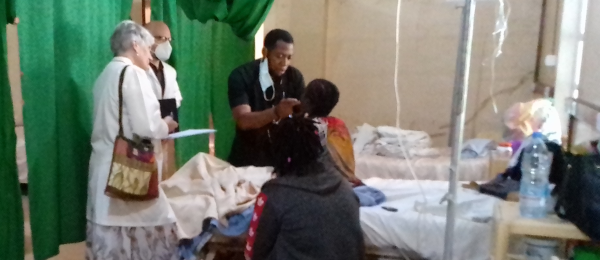Click here to view this newsletter as a PDF.
One of the challenges we face on a regular basis pertains to the ravages of HIV – which is endemic in our population. Thankfully, antiretroviral therapy has routinely been available to patients in this setting for over two decades. Yet the stigma associated with being HIV-positive still persists, and many patients find various ways to hide their positive serologic status from even their closest relatives. Evasive behavior may involve sequestering one’s antiretroviral medication and/or refusing to take it or to return for follow-up so as not to arouse the suspicion of others. One such patient by the name of Gladys came to us from Bioko – an island off the west coast of Cameroon. Her symptoms were tied to advanced cervical cancer. The incidence of cervical cancer is very high in the developing world – especially in HIV-infected women who have acquired yet another sexually transmitted infection caused by the Human Papilloma Virus (HPV). There is extensive evidence linking HPV infection to cervical carcinoma. Chronic HPV infection of the cervix can lead to dysplastic changes and eventual malignancy. Because HIV-infected women cannot mount the desired immunologic response to HPV, they are more susceptible to the complications of disease caused by this virus.

Speaking with Gladys and her caregiver – along with a first-year resident.
When Gladys came to us, her cervical cancer had progressed beyond the point of cure. Over a decade ago, the Cameroon Baptist Convention Health Board developed a cervical cancer screening program in an attempt to identify cervical changes associated with HPV infection. Women whose screening test is positive benefit from intervention prior to the development of neoplasia. Unfortunately, Gladys lived too far away to benefit from screening and only sought medical attention when her disease was already advanced. At the time of presentation, her cervical cancer had led to pelvic pain and renal impairment. While it was possible to see some recovery of her kidney function, it was necessary to explain to Gladys that we lacked modalities to adequately treat her malignancy. Even palliative chemotherapy poses a risk insofar as the added immunosuppression engendered by chemotherapy predictably leads to further immunologic deterioration. Gladys listened to our counsel calmly and intelligently. Understandably, the tears came over the prospect of her incurable disease.
It is very difficult to tell a patient that we have nothing to offer by way of treatment – especially in a context where one once again has to invoke the issue of HIV disease. In Glady’s case, her HIV infection had not only contributed to her malignancy but was also responsible for the limitations faced in trying to offer treatment for it. In Sub-Saharan Africa, the specter of HIV remains an ever-present source of stigma, pain, and suffering decades after the virus was first discovered.
The approach we have taken over the years is to try to step back with patients as we consider our own mortality. We sometimes explain that the ultimate problem is not being HIV positive. Rather, the problem is that each one of us is SIN positive. In fact, because we are SIN-positive, we can expect to one day die. We spoke to her about the necessity of believing on The Lord Jesus Christ – who has provided the only perfect and sufficient sacrifice for sin. Gladys shared that she had followed Islam after marrying a Muslim man. Currently estranged from her husband, she had turned back to Christianity. Yet, this is not a matter of what may be societally acceptable or desirable in one’s particular social context. We asked her, “Did Christ Jesus actually die for sin and rise from the dead such that what one believes concerning Him actually matters?” Gladys assured us that she understood “very well” and planned to go home to address matters with her family. With her pain under control, she was discharged on analgesics, as well as antiretroviral therapy – which she takes faithfully.
During the latter part of October and first week of November, our residents are undergoing final exams. We are thankful that our external examiner from Canada – Dr. Brian Wirzba – was able to join us for this purpose. After delivering a 100-question multiple choice written exam, he has been in the process of individually examining each resident.
Shown below is the examination of a second-year resident. Dr. Wirzba is flanked by another physician, Dr. Kaye Streatfeild from Australia. Dr. Kaye has been a great blessing to our residents as she has worked tirelessly at refining their physical examination skills in preparation for this time. It remains to be seen whether all will pass. But, in the words of our very wise and gifted chief resident, “All will definitely learn through the experience.”

Dr. Kaye (foreground) and Dr. Wirzba examine a second-year CIMS resident at the bedside.
